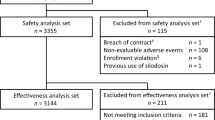Abstract
Patients with presumed non-obstructive BPH (Q max ≥ 15 ml/s) treated with tolterodine ER 4 mg/day for OAB symptoms, alone or added to unsuccessful alpha-blocker treatment of ≥6 weeks duration, were observed for 12 weeks in a non-interventional study to generate real-life efficacy and safety data. Patients completed the IPSS, the OAB-q and a 2-day micturition diary at baseline and 12 weeks. PVR was determined sonographically. Seven hundred and forty one patients were analysed. Mean PVR did not increase (25.4 ± 26.5 vs. 29.3 ± 30.9 ml at baseline). AUR requiring catheterization occurred in two patients, acute UTI in four patients. Median IPSS total scores decreased from 17 to 10, IPSS QoL scores from 4 to 2, OAB-q symptom bother scores from 50.0 to 22.5 and OAB-q HRQL scores increased from 59.2 to 81.6. In men with OAB symptoms and presumed non-obstructive BPH, tolterodine ER provided considerable symptomatic and QoL improvements with a low risk of AUR, acute UTI, or increased PVR.
Similar content being viewed by others
References
Abrams P, Cardozo L, Fall M et al (2003) The standardisation of terminology in lower urinary tract function: report from the standardisation sub-committee of the international continence society. Urology 61:37–49
Abrams P, Cardozo L, Khoury S et al (2005) Incontinence. Management, vol 2. Health Publication Ltd, Plymouth
Athanasopoulos A, Gyftopoulos K, Giannitsas K et al (2003) Combination treatment with an alpha-blocker plus an anticholinergic for bladder outlet obstruction: a prospective, randomized, controlled study. J Urol 169:2253–2256
Barry MJ, Fowler FJ Jr, O’Leary MP et al (1992) The American Urological Association symptom index for benign prostatic hyperplasia. The Measurement Committee of the American Urological Association. J Urol 148:1549–1557, discussion 1564
Cockett ATK AY, Chatelain C et al (1991) Recommendations of the International Consensus Committee. In: Cockett ATK AY, Chatelain C et al (eds) Proceedings of the international consultation on benign prostatic hyperplasia (BPH). Paris, pp 279–288
Coyne K, Revicki D, Hunt T et al (2002) Psychometric validation of an overactive bladder symptom and health-related quality of life questionnaire: the OAB-q. Qual Life Res 11:563–574
Coyne KS, Matza L, Kopp Z et al (2005) Determining the minimally important difference of the overactive bladder questionnaire (OAB-q). Value Health 8(6):A9
Kaplan SA, Walmsley K, Te AE (2005) Tolterodine extended release attenuates lower urinary tract symptoms in men with benign prostatic hyperplasia. J Urol 174:2273–2275, discussion 2275–2276
Layton D, Pearce GL, Shakir SA (2001) Safety profile of tolterodine as used in general practice in England: results of prescription-event monitoring. Drug Saf 24:703–713
Lee JY, Kim HW, Lee SJ et al (2004) Comparison of doxazosin with or without tolterodine in men with symptomatic bladder outlet obstruction and an overactive bladder. BJU Int 94:817–820
Lim E, Chia SJ (2005) Combination therapy using alpha-blocker and antimuscarinic drugs in men with lower urinary tract symptoms suggestive of bladder outlet obstruction and an overactive bladder: is it safe and efficacious? International Continence Society ICS, Montreal. http://www.continet.org/publications/2005/pdf/0205.pdf
Madersbacher S, Alivizatos G, Nordling J et al (2004) EAU 2004 guidelines on assessment, therapy and follow-up of men with lower urinary tract symptoms suggestive of benign prostatic obstruction (BPH guidelines). Eur Urol 46:547–554
McConnell JD, Roehrborn CG, Bautista OM et al (2003) The long-term effect of doxazosin, finasteride, and combination therapy on the clinical progression of benign prostatic hyperplasia. N Engl J Med 349:2387–2398
Meigs JB, Barry MJ, Giovannucci E et al (1999) Incidence rates and risk factors for acute urinary retention: the health professionals followup study. J Urol 162:376–382
Michel MC, de la Rosette JJ, Piro M et al (2004) Does concomitant stress incontinence alter the efficacy of tolterodine in patients with overactive bladder? J Urol 172:601–604
Michel MC, Mehlburger L, Bressel HU et al (1998) Tamsulosin treatment of 19,365 patients with lower urinary tract symptoms: does co-morbidity alter tolerability? J Urol 160:784–791
Michel MC, Schneider T, Krege S et al (2002) Does gender or age affect the efficacy and safety of tolterodine? J Urol 168:1027–1031
Okada H, Shirakawa T, Muto S et al (2004) Propiverine hydrochloride relieves irritative symptoms of benign prostatic hyperplasia. J Urol 171 (Suppl):abstract 1358
Hartung J (1993) Statistik, Lehr- und Handbuch der angewandten Statistik. 9th edn. Oldenbourg, München Wien, p 204
Rackley R, Weiss J, Rovner ES et al (2007) Nighttime dosing with tolterodine reduces overactive bladder-related nocturnal micturitions in patients with overactive bladder and nocturia. Urology (in press)
Roehrborn CG, Bruskewitz R, Nickel JC et al (2004) Sustained decrease in incidence of acute urinary retention and surgery with finasteride for 6 years in men with benign prostatic hyperplasia. J Urol 171:1194–1198
Roehrborn CG, McConnell JD, Barry MJ et al (2003) AUA guideline on the management of benign prostatic hyperplasia. http://www.auanet.org/timssnet/products/guidelines/main_reports/bph_management/preface_toc.pdf
Saito H, Yamada T, Oshima H et al (1999) A comparative study of the efficacy and safety of tamsulosin hydrochloride alone and combination of propiverine hydrochloride and tamsulosin in the benign prostatic hypertrophy with pollakiuria and/or urinary incontinence. Jpn J Urol Surg 12:525–536
van Kerrebroeck P, Abrams P, Chaikin D et al (2002) The standardisation of terminology in nocturia: report from the Standardisation Sub-committee of the International Continence Society. Neurourol Urodyn 21:179–183
Verhamme KM, Dieleman JP, van Wijk MA et al (2005) Low incidence of acute urinary retention in the general male population: the triumph project. Eur Urol 47:494–498
Acknowledgments
We are indebted to the 284 investigators who documented the patients in this trial.
Author information
Authors and Affiliations
Corresponding author
Additional information
Supported by Pfizer Pharma GmbH.
Rights and permissions
About this article
Cite this article
Höfner, K., Burkart, M., Jacob, G. et al. Safety and efficacy of tolterodine extended release in men with overactive bladder symptoms and presumed non-obstructive benign prostatic hyperplasia. World J Urol 25, 627–633 (2007). https://doi.org/10.1007/s00345-007-0212-5
Accepted:
Published:
Issue Date:
DOI: https://doi.org/10.1007/s00345-007-0212-5




